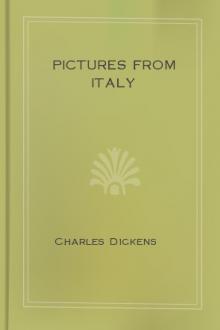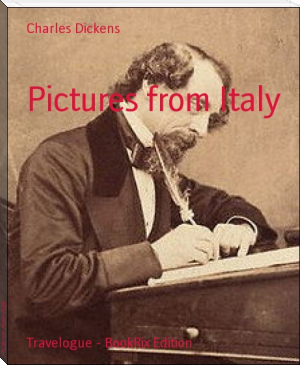Travels Through France And Italy, Tobias Smollett [love novels in english .TXT] 📗

- Author: Tobias Smollett
Book online «Travels Through France And Italy, Tobias Smollett [love novels in english .TXT] 📗». Author Tobias Smollett
With Thy Lov'd Corse The Fire Shall Now Consume.
Even Virgil Makes His Pious Hero Sacrifice Eight Italian Youths
To The Manes Of Pallas. It Is Not At All Clear To Me, That A
People Is The More Brave, The More They Are Accustomed To
Bloodshed In Their Public Entertainments. True Bravery Is Not
Savage But Humane. Some Of This Sanguinary Spirit Is Inherited By
The Inhabitants Of A Certain Island That Shall Be Nameless--But,
Mum For That. You Will Naturally Suppose That The Coliseo Was
Ruined By The Barbarians Who Sacked The City Of Rome: In Effect,
They Robbed It Of Its Ornaments And Valuable Materials; But It
Was Reserved For The Goths And Vandals Of Modern Rome, To
Dismantle The Edifice, And Reduce It To Its Present Ruinous
Condition. One Part Of It Was Demolished By Pope Paul Ii. That He
Might Employ The Stones Of It In Building The Palace Of St. Mark.
It Was Afterwards Dilapidated For The Same Purposes, By The
Cardinals Riarius And Farnese, Which Last Assumed The Tiara Under
The Name Of Paul Iii. Notwithstanding These Injuries, There Is
Enough Standing To Convey A Very Sublime Idea Of Ancient
Magnificence.
The Circi And Naumachia, If Considered As Buildings And
Artificial Basins, Are Admirable; But If Examined As Areae
Intended For Horse And Chariot Races, And Artificial Seas For
Exhibiting Naval Engagements, They Seem To Prove That The Antient
Romans Were But Indifferently Skilled And Exercised Either In
Horsemanship Or Naval Armaments. The Inclosure Of The Emperor
Caracalla's Circus Is Still Standing, And Scarce Affords
Part 7 Letter 32 ( Nice, March 10, 1765.) Pg 260Breathing Room For An English Hunter. The Circus Maximus, By Far
The Largest In Rome, Was Not So Long As The Mall; And I Will
Venture To Affirm, That St. James's Park Would Make A Much More
Ample And Convenient Scene For Those Diversions. I Imagine An Old
Roman Would Be Very Much Surprised To See An English Race On The
Course At New-Market. The Circus Maximus Was But Three Hundred
Yards In Breadth. A Good Part Of This Was Taken Up By The Spina,
Or Middle Space, Adorned With Temples, Statues, And Two Great
Obelisks; As Well As By The Euripus, Or Canal, Made By Order Of
Julius Caesar, To Contain Crocodiles, And Other Aquatic Animals,
Which Were Killed Occasionally. This Was So Large, That
Heliogabalus, Having Filled It With Excellent Wine, Exhibited
Naval Engagements In It, For The Amusement Of The People. It
Surrounded Three Sides Of The Square, So That The Whole Extent Of
The Race Did Not Much Exceed An English Mile; And When Probus Was
At The Expence Of Filling The Plain Of It With Fir-Trees To Form
A Wood For The Chace Of Wild Beasts, I Question Much If This
Forest Was More Extensive Than The Plantation In St. James's
Park, On The South Side Of The Canal: Now I Leave You To Judge
What Ridicule A King Of England Would Incur By Converting This
Part Of The Park Into A Chace For Any Species Of Animals Which
Are Counted Game In Our Country.
The Roman Emperors Seemed More Disposed To Elevate And Surprize,
Than To Conduct The Public Diversions According To The Rules Of
Reason And Propriety. One Would Imagine, It Was With This View
They Instituted Their Naumachia, Or Naval Engagements, Performed
By Half A Dozen Small Gallies Of A Side In An Artificial Basin Of
Fresh Water. These Gallies I Suppose Were Not So Large As Common
Fishing-Smacks, For They Were Moved By Two, Three, And Four Oars
Of A Side According To Their Different Rates, Biremes, Triremes,
And Quadriremes. I Know This Is A Knotty Point Not Yet
Determined; And That Some Antiquarians Believe The Roman Gallies
Had Different Tires Or Decks Of Oars; But This Is A Notion Very
Ill Supported, And Quite Contrary To All The Figures Of Them That
Are Preserved On Antient Coins And Medals. Suetonius In The Reign
Of Domitian, Speaking Of These Naumachia, Says, "Edidit Navales
Pugnas, Pene Justarum Classium, Effosso, Et Circumducto Juxta
Tyberim Lacu, Atque Inter Maximas Imbres Prospectavit," "He
Exhibited Naval Engagements Of Almost Intire Fleets, In An
Artificial Lake Formed For The Purpose Hard By The Tyber, And
Viewed Them In The Midst Of Excessive Rains." This Artificial
Lake Was Not Larger Than The Piece Of Water In Hyde-Park; And Yet
The Historian Says, It Was Almost Large Enough For Real Or Intire
Fleets. How Would A British Sailor Relish An Advertisement That A
Mock Engagement Between Two Squadrons Of Men Of War Would Be
Exhibited On Such A Day In The Serpentine River? Or That The
Ships Of The Line Taken From The Enemy Would Be Carried In
Procession From Hyde-Park-Corner To Tower-Wharf? Certain It Is,
Lucullus, In One Of His Triumphs, Had One Hundred And Ten Ships
Of War (Naves Longas) Carried Through The Streets Of Rome.
Nothing Can Give A More Contemptible Idea Of Their Naval Power,
Part 7 Letter 32 ( Nice, March 10, 1765.) Pg 261Than This Testimony Of Their Historians, Who Declare That Their
Seamen Or Mariners Were Formed By Exercising Small Row-Boats In
An Inclosed Pool Of Fresh Water. Had They Not The Sea Within A
Few Miles Of Them, And The River Tyber Running Through Their
Capital! Even This Would Have Been Much More Proper For
Exercising Their Watermen, Than A Pond Of Still-Water, Not Much
Larger Than A Cold-Bath. I Do Believe In My Conscience That Half
A Dozen English Frigates Would Have Been Able To Defeat Both The
Contending Fleets At The Famous Battle Of Actium, Which Has Been
So Much Celebrated In The Annals Of Antiquity, As An Event That
Decided The Fate Of Empire.
It Would Employ Me A Whole Month To Describe The Thermae Or
Baths, The Vast Ruins Of Which Are Still To Be Seen Within The
Walls Of Rome, Like The Remains Of So Many Separate Citadels. The
Thermae Dioclesianae Might Be Termed An August Academy For The
Use And Instruction Of The Roman People. The Pinacotheca Of This
Building Was A Complete Musaeum Of All The Curiosities Of Art And
Nature; And There Were Public Schools For All The Sciences. If I
May Judge By My Eye, However, The Thermae Antonianae Built By
Caracalla, Were Still More Extensive And Magnificent; They
Contained Cells Sufficient For Two Thousand Three Hundred Persons
To Bathe At One Time, Without Being Seen By One Another. They
Were Adorned With All The Charms Of Painting, Architecture, And
Sculpture. The Pipes For Convoying The Water Were Of Silver. Many
Of The Lavacra Were Of Precious Marble, Illuminated By Lamps Of
Chrystal. Among The Statues, Were Found The Famous Toro, And
Hercole Farnese.
Bathing Was Certainly Necessary To Health And Cleanliness In A
Hot Country Like Italy, Especially Before The Use Of Linen Was
Known: But These Purposes Would Have Been Much Better Answered By
Plunging Into The Tyber, Than By Using The Warm Bath In The
Thermae, Which Became Altogether A Point Of Luxury Borrowed From
The Effeminate Asiatics, And Tended To Debilitate The Fibres
Already Too Much Relaxed By The Heat Of The Climate. True It Is,
They Had Baths Of Cool Water For The Summer: But In General They
Used It Milk-Warm, And Often Perfumed: They Likewise Indulged In
Vapour-Baths, In Order To Enjoy A Pleasing Relaxation, Which They
Likewise Improved With Odoriferous Ointments.
The Thermae Consisted Of A Great Variety Of Parts And
Conveniences; The Natationes, Or Swimming Places; The Portici,
Where People Amused Themselves In Walking, Conversing, And
Disputing Together, As Cicero Says, In Porticibus Deambulantes
Disputabant; The Basilicae, Where The Bathers Assembled, Before
They Entered, And After They Came Out Of The Bath; The Atria, Or
Ample Courts, Adorned With Noble Colonnades Of Numidian Marble
Part 7 Letter 32 ( Nice, March 10, 1765.) Pg 262And Oriental Granite; The Ephibia, Where The Young Men Inured
Themselves To Wrestling And Other Exercises; The Frigidaria, Or
Places Kept Cool By A Constant Draught Of Air, Promoted By The
Disposition And Number Of The Windows; The Calidaria, Where The
Water Was Warmed For The Baths; The Platanones, Or Delightful
Groves Of Sycamore; The Stadia, For The Performances Of The
Athletae; The Exedrae, Or Resting-Places, Provided With Seats For
Those That Were Weary; The Palestrae, Where Every One Chose That
Exercise Which Pleased Him Best; The Gymnasia, Where Poets,
Orators, And Philosophers Recited Their Works, And Harangued For
Diversion; The Eleotesia, Where The Fragrant Oils And Ointments
Were Kept For The Use Of The Bathers; And The Conisteria, Where
The Wrestlers Were Smeared With Sand Before They Engaged. Of The
Thermae In Rome, Some Were Mercenary, And Some Opened Gratis.
Marcus Agrippa, When He Was Edile, Opened One Hundred And Seventy
Private Baths, For The Use Of The People. In The Public Baths,
Where Money Was Taken, Each Person Paid A Quadrans, About The
Value Of Our Halfpenny, As Juvenal Observes,
Caedere Sylvano Porcum, Quadrante Lavari.
The Victim Pig To God Sylvanus Slay,
And For The Public Bath A Farthing Pay.
But After The Hour Of Bathing Was Past, It Sometimes Cost A Great
Deal More, According To Martial,
Balnea Post Decimam, Lasso Centumque Petuntur
Quadrantes--
The Bathing Hour Is Past, The Waiter Tir'd;
An Hundred Farthings Now Will Be Requir'd.
Though There Was No Distinction In The Places Between The First
Patrician And The Lowest Plebeian, Yet The Nobility Used Their
Own Silver And Gold Plate, For Washing, Eating, And Drinking In
The Bath, Together With Towels Of The Finest Linen. They Likewise
Made Use Of The Instrument Called Strigil, Which Was A Kind Of
Flesh-Brush; A Custom To Which Persius Alludes In This Line,
Part 7 Letter 32 ( Nice, March 10, 1765.) Pg 263
I Puer, Et Strigiles Crispini Ad Balnea Defer.
Here, Boy, This Brush To Crispin's Bagnio Bear.
The Common People Contented





Comments (0)